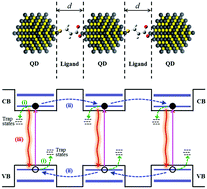
penghuang
Shared posts
Rational Design: A High-Throughput Computational Screening and Experimental Validation Methodology for Lead-Free and Emergent Hybrid Perovskites
The Surface of Hybrid Perovskite Crystals: A Boon or Bane

Air-Induced High-Quality CH3NH3PbI3 Thin Film for Efficient Planar Heterojunction Perovskite Solar Cells
Influence of the Dimensionality and Organic Cation on Crystal and Electronic Structure of Organometallic Halide Perovskites
Thermal degradation of luminescence in inorganic perovskite CsPbBr3 nanocrystals
DOI: 10.1039/C6CP08824D, Paper
The PL degradation of annealed CsPbBr3 NCs is related to both the formation of surface defects and growth of NCs.
The content of this RSS Feed (c) The Royal Society of Chemistry
Modified Fullerenes for Efficient Electron Transport Layer-Free Perovskite/Fullerene Blend-Based Solar Cells
Abstract
A variety of novel chemically modified fullerenes, showing different electron-accepting capabilities, has been synthesized and used to prepare electron transport layer (ETL)-free solar cells based on perovskite/fullerene blends. In particular, isoxazolino[60] fullerenes are proven to be a good candidate for processing blend films with CH3NH3PbI3 and obtaining enhanced power conversion efficiency (PCE) ETL-free perovskite solar cells (PSCs), improving the state-of-the-art PCE (i.e., 14.3 %) for this simplified device architecture. A beneficial effect for pyrazolino and methano[60]fullerene derivatives versus pristine [60]/fullerene is also shown. Furthermore, a clear correlation between the LUMO energy level of the fullerene component and the open circuit voltage of the solar cells is found. Apart from the new knowledge on innovative fullerene derivatives for PSCs, the universality and versatility of perovskite/fullerene blend films to obtain efficient ETL-free PSCs is demonstrated.

Blending things up: New CH3NH3PbI3/fullerene blends based on a variety of fullerene derivatives (i.e., isoxazolino, pyrazolino, and methano[60]fullerenes) are demonstrated for the fabrication of electron transport layer-free solar cells that efficiently (i.e., up to 14.3 %) convert sunlight into electricity.
Perovskite Solar Cells: The Birth of a New Era in Photovoltaics

Over 20% Efficient CIGS–Perovskite Tandem Solar Cells

Optimization of Stable Quasi-Cubic FAxMA1–xPbI3 Perovskite Structure for Solar Cells with Efficiency beyond 20%

Benign Interfacial Iodine Vacancies in Perovskite Solar Cells
Efficient Organic Photovoltaics with Improved Charge Extraction and High Short-Circuit Current
Modeling Ultrafast Exciton Migration within the Electron Donor Domains of Bulk Heterojunction Organic Photovoltaics
Highly Emissive Divalent-Ion-Doped Colloidal CsPb1–xMxBr3 Perovskite Nanocrystals through Cation Exchange
Donor-π–Acceptor Based Stable Porphyrin Sensitizers for Dye-Sensitized Solar Cells: Effect of π-Conjugated Spacers
Improved Reproducibility for Perovskite Solar Cells with 1 cm2 Active Area by a Modified Two-Step Process
Donor–Acceptor Interface Stabilizer Based on Fullerene Derivatives toward Efficient and Thermal Stable Organic Photovoltaics
Enhanced Photovoltaic Performance of Mesoscopic Perovskite Solar Cells by Controlling the Interaction between CH3NH3PbI3 Films and CsPbX3 Perovskite Nanoparticles
Transparent Conductive Oxide Layer and Hole Selective Layer Free Back-Contacted Hybrid Perovskite Solar Cell
Modification of Solar Energy Harvesting in Photovoltaic Materials by Plasmonic Nanospheres: New Absorption Bands in Perovskite Composite Film
Non-fullerene organic solar cells based on diketopyrrolopyrrole polymers as electron donors and ITIC as an electron acceptor
DOI: 10.1039/C7CP00494J, Paper
Non-fullerene organic solar cells based on diketopyrrolopyrrole polymers as electron donors and ITIC as an electron acceptor were studied to show power conversion efficiencies of 4% with external quantum efficiencies above 0.4.
The content of this RSS Feed (c) The Royal Society of Chemistry
Morphology Evolution and Degradation of CsPbBr3 Nanocrystals under Blue Light-Emitting Diode Illumination
Modifying the Chemical Structure of a Porphyrin Small Molecule with Benzothiophene Groups for the Reproducible Fabrication of High Performance Solar Cells
CH3NH3PbI3–xClx under Different Fabrication Strategies: Electronic Structures and Energy-Level Alignment with an Organic Hole Transport Material
Modification of the Highly Conductive PEDOT:PSS Layer for Use in Silver Nanogrid Electrodes for Flexible Inverted Polymer Solar Cells
Enhanced Efficiency and Stability of Perovskite Solar Cells via Anti-Solvent Treatment in Two-Step Deposition Method
Effect of Selective Contacts on the Thermal Stability of Perovskite Solar Cells
Efficient Fullerene-Free Polymer Solar Cells Based on Alkylthio Substituted Conjugated Polymers
High Detectivity and Rapid Response in Perovskite CsPbBr3 Single-Crystal Photodetector
Ligand-dependent exciton dynamics and photovoltaic properties of PbS quantum dot heterojunction solar cells
DOI: 10.1039/C6CP06561A, Paper
Surface ligand effects on the exciton dynamics and photovoltaic properties of PbS QDHSCs were systematically investigated.
The content of this RSS Feed (c) The Royal Society of Chemistry























